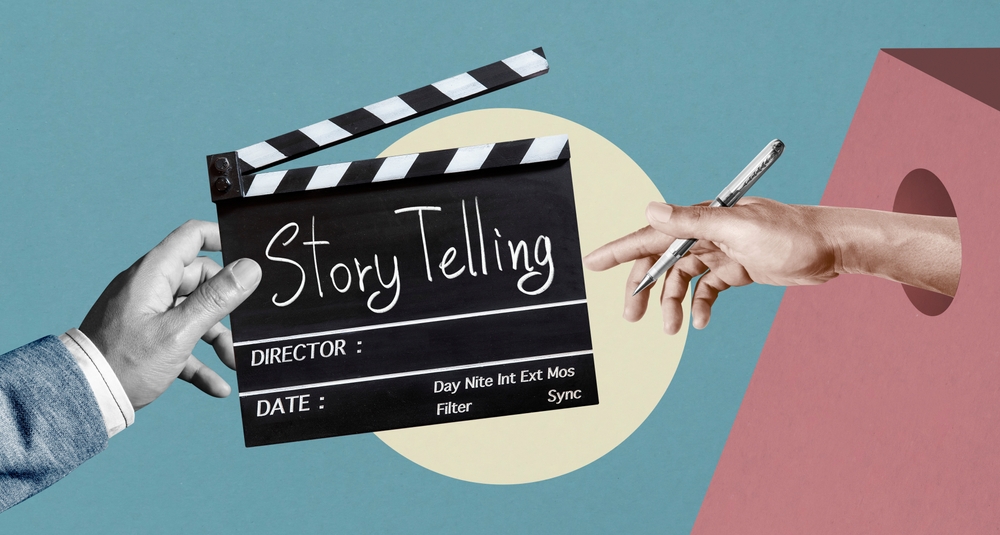Every business aims to effectively engage customers and increase sales. The natural instinct might be to shout your products from every rooftop, every social media channel, and every blinking billboard. However, people don’t always respond to straightforward pitches.
Enter storytelling marketing. Famed psychologist Jerome Bruner tells us the human mind is 22 times more likely to remember facts presented within a story. Imagine weaving your brand and products into a captivating narrative, one that resonates with your audience on an emotional level. But crafting a compelling story isn’t always simple.
This blog will provide a definition of storytelling marketing and explain the nitty-gritty of crafting effective stories to drive your business toward success. We’ll also provide success stories of storytelling marketing and actionable tips to inspire you to create your own narratives and be top of mind for your target market.
What is Storytelling Marketing?
Storytelling marketing is the strategic use of narratives to convey your message and connect with audiences emotionally. It typically features your target market, highlights the problems you can solve for them, and incorporates your brand’s services and culture. Ultimately, it aims to drive your customers to purchase your offerings.
Why Storytelling Marketing Matters
Storytelling marketing is not just an art; it’s a scientifically backed strategy for driving sales and attracting audiences. Studies show its profound impact on the brain’s chemical reactions.
When engaged in a story, our brains release key neurotransmitters like cortisol, dopamine, and oxytocin. Cortisol helps us remember information better, while dopamine keeps us interested in a story. Finally, oxytocin helps us feel connected to brands when stories evoke emotions like empathy.
Understanding the science behind this marketing strategy can help you craft narratives that resonate emotionally, forging deeper bonds with your audience and influencing purchasing decisions. In essence, storytelling marketing is about conveying information and triggering emotional responses that lead to sales.
Elements of Effective Storytelling Marketing
Similar to setting the stage for a novel or play, your marketing story should include the following four key elements.
1. Audience
Effective storytelling marketing begins with understanding your target audience’s needs and interests. Research your demographic and create buyer personas to create a relatable story, ensure it meets their expectations, and engages your customers’ emotions.
2. Characters
A captivating story needs relatable characters, especially a hero. The protagonist should embody the struggles and aspirations of your target audience, mirroring their hopes and fears. This way, the hero becomes a vessel for viewers to project their own journeys.
3. Conflict
Conflict is essential for creating compelling and believable stories. Audiences relate to a hero’s struggles because they face conflicts in their own lives. Storytelling marketing thus encourages your audience to root for the hero and become emotionally invested in the narrative.
4. Resolution
A story’s resolution determines its impact. Does the hero overcome the challenges they face? How? The resolution should provide closure, answer questions, and fulfill the emotional journey established throughout the story.
This element showcases the power of your product or service in helping the hero achieve their goals, leaving viewers with a sense of hope and a clear path to solving their own problems.
Examples of Successful Storytelling Marketing Campaigns
Hundreds of brands worldwide have taken the unconventional route of telling stories rather than directly promoting their products. Here are some examples to show what storytelling is in marketing.
1. GCash stories
Since its inception in 2004, GCash has evolved into a digital powerhouse. It now has 71 million users, which is more than the populations of South Korea, South Africa, and even the UK.
With such a vast user base, GCash’s parent company, Mynt, capitalized on its marketing potential through compelling storytelling.
In 2023, Mynt launched the GCash Stories video series, showcasing the experiences of Filipinos using the e-wallet for loans, donations, and income generation. Each narrative underscored the resilience ingrained in Filipino culture, highlighting their ability to overcome challenges and strive for a better life for themselves and their families.
The series proved successful because it garnered millions of views, with one video even reaching 31 million as of this writing. To complement the video series, GCash also launched an engagement campaign encouraging users to share their GCash story for a chance to win ₱10,000 worth of prizes.
Through this marketing effort, GCash showed its commitment to being a digital staple and how it can help users with their finances.
2. Dove Real Beauty Sketches
Dove has become synonymous with empowerment and inclusivity because of its personal care products. With a focus on real beauty and authenticity, it strives to challenge conventional beauty standards and celebrate diversity in all its forms.
In 2013, Dove launched its iconic Real Beauty Sketches campaign, which epitomized its commitment to promoting a positive self-image. The project featured women describing themselves to a forensic artist, who sketched them based on their descriptions. Strangers then described the same women, resulting in two different sketches.
Dove featured this effort in a short film, which garnered more than 50 million views within 12 days of its release. The campaign also generated 4.6 billion PR and blogger media impressions and received many awards. It even inspired multiple parodies, some of which went viral.
Through this powerful campaign, Dove revealed the stark contrast between how women perceive themselves and how others see them, proving that women are more beautiful than they realize. It challenged beauty norms and encouraged women to embrace their individual beauty, sparking discussions and promoting positive self-perception.
3. Share a Coke (Coca-Cola)
If there’s one thing Coca-Cola is known for beyond its iconic drink, it’s its marketing campaigns. In 2012, Coca-Cola introduced the “Share a Coke” campaign. They put popular names on Coke bottles instead of their logo, urging people to share a drink with friends and family whose names were on the bottle.
The campaign’s goal was to revitalize Coca-Cola’s brand image and tap into the universal desire for personalization and connection. Fortunately, the company achieved just that.
The project sparked widespread enthusiasm among consumers, leading to increased sales and brand loyalty. Coca-Cola reported a 2% increase in sales in the United States following the campaign’s launch, marking a significant turnaround from previous years of decline.
Moreover, “Share a Coke” garnered extensive media coverage and social media buzz, further amplifying its impact and solidifying its status as one of Coca-Cola’s most successful marketing initiatives.
How to Implement Storytelling Marketing In Your Campaign
You have the power of storytelling. It’s just a matter of turning it into a marketing opportunity. Here are some tips on creating memorable, heart-tugging campaigns.
1. Define your brand identity and message
Before crafting your narrative, solidify your brand identity. What message do you want to convey? Who are you trying to reach? A clear brand identity ensures consistency and targets the right audience.
2. Set a clear goal for your story
What do you want your audience to do after experiencing your story? Do you want them to visit your website, download an ebook, or make a purchase? Having a clear goal can help you create a compelling call to action (CTA) at the story’s end.
Even if you don’t drive customers to take action, a captivating story will help them remember your brand and associate it with positive emotions.
3. Incorporate visual storytelling
Did you know that the brain processes images 60,000 times faster than text and that 90% of the information sent to the brain is visual? That’s why when it comes to storytelling marketing, it’s recommended to go beyond text.
Incorporate visuals like images, videos, or infographics to enhance engagement and comprehension. You can even partner with popular content creators to support your multimedia efforts and promote your campaign.
Remember, a picture (or video) is worth a thousand words!
4. Measure and optimize
Don’t just tell your story—measure its impact! Track metrics such as views, clicks, shares, and audience feedback. This data reveals what resonates and allows you to refine your approach for future stories.
Let’s say you’re a fashion brand, and you decide to post a series of Instagram stories featuring behind-the-scenes footage of your design process and interviews with your team members. After each story, you track metrics like views, swipe-ups, and comments.
After reviewing the data, you find that your audience prefers stories about your team’s creative process over product-focused ones. They value the authenticity and human touch of your brand. With this understanding, you can shift your content strategy towards more storytelling and less product promotion.
Time to Tell Your Story
The importance of storytelling in marketing lies in its ability to forge emotional connections that traditional advertising often struggles to achieve.
Imagine customers not just remembering your brand but actively seeking it out—following you on social media, becoming loyal buyers, or even spreading the word. Stories have the power to ignite this kind of loyalty, making them the gold standard in marketing.
Ready to craft a narrative that resonates for years to come? Let Spiralytics help! We’re a digital marketing agency that can help you establish a strong online presence and become the go-to brand for your target market.
Contact us to discuss how we can turn your brand story into a marketing masterpiece.





